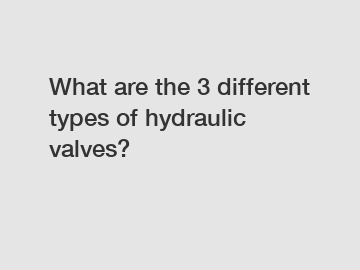What are the 3 different types of hydraulic valves?
Huade Hydraulic supply professional and honest service.
Hydraulic valves play a crucial role in controlling the flow of fluid in hydraulic systems. Understanding the different types of hydraulic valves is essential for maintaining efficient and reliable operations in various industrial applications. This article aims to explore the three different types of hydraulic valves, their origins, the rationale behind their design, and their significance in hydraulic systems.
What are the 3 different types of hydraulic valves?

The three different types of hydraulic valves are:
1) Directional Control Valves: These valves regulate the direction of fluid flow within a hydraulic system.
2) Pressure Control Valves: These valves control the pressure levels within a hydraulic system by regulating the flow rate or releasing excess fluid.
3) Flow Control Valves: These valves control and regulate the flow rate of fluid within a hydraulic system.
Origins and rationale behind the three types of hydraulic valves:
The origins of these hydraulic valves can be traced back to the early advancements in fluid power systems. As hydraulic systems became more sophisticated, there was a need to develop valves capable of controlling various aspects, such as the direction, pressure, and flow rate of fluid. Hence, the three distinct types of hydraulic valves emerged.
Directional Control Valves:
Directional control valves originated from the need to control the direction of fluid flow. By using mechanical or electronic means, these valves allow the operator to direct the fluid to specific hydraulic actuators, such as cylinders or motors. This enables precise control over the movement of machinery or equipment, increasing operational efficiency and safety.
Pressure Control Valves:
Pressure control valves were developed to regulate the pressure levels within hydraulic systems. Overly high or low pressure can cause damage to equipment or compromise system performance. These valves ensure that the pressure remains within specified limits by adjusting the flow rate or diverting excess fluid to a reservoir or bypass line. This prevents system failures and enhances equipment lifespan.
Flow Control Valves:
Flow control valves were designed to regulate the flow rate of fluid within hydraulic systems. They allow the operator to adjust the speed or rate at which hydraulic actuators move, ensuring smooth and controlled operation. By precisely controlling the speed and extent of equipment movements, flow control valves optimize productivity, reduce energy consumption, and minimize wear and tear on system components.
Significance and impact of the three types of hydraulic valves:
The three types of hydraulic valves are indispensable in various industries where hydraulic systems are employed, such as manufacturing, construction, and agriculture. Their ability to control fluid direction, pressure, and flow rate ensures efficient and safe operation of machinery and equipment.
Moreover, these valves contribute to the overall reliability, durability, and lifespan of hydraulic systems. They prevent overload conditions, mitigate the risk of hydraulic system failures, and enable smooth and precise movements, enhancing productivity and reducing downtime.
In conclusion, understanding the three different types of hydraulic valves – directional control valves, pressure control valves, and flow control valves – is crucial for anyone involved in hydraulic systems. They provide critical control over fluid flow, pressure, and speed, ensuring optimal performance and longevity of hydraulic systems across numerous industries.
For more wholesale Rotary Directional Valveinformation, please contact us. We will provide professional answers.



